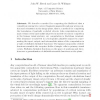Free Online Productivity Tools
i2Speak
i2Symbol
i2OCR
iTex2Img
iWeb2Print
iWeb2Shot
i2Type
iPdf2Split
iPdf2Merge
i2Bopomofo
i2Arabic
i2Style
i2Image
i2PDF
iLatex2Rtf
Sci2ools
ECCV
2000
Springer
2000
Springer
Euclidean Group Invariant Computation of Stochastic Completion Fields Using Shiftable-Twistable Functions
We describe a method for computing the likelihood that a completion joining two contour fragments passes through any given position and orientation in the image plane, that is, a method for completing the boundaries of partially occluded objects. Like computations in primary visual cortex (and unlike all previous models of contour completion in the human visual system), our computation is Euclidean invariant. This invariance is achieved in a biologically plausible manner by representing the input, output, and intermediate states of the computation in a basis of shiftable-twistable functions. The spatial components of these functions resemble the receptive fields of simple cells in primary visual cortex. Shiftable-twistable functions on the space of positions and directions are a generalization of shiftable-steerable functions on the plane.
Computer Vision | Contour Completion | Contour Fragments Passes | ECCV 2000 | Human Visual System | Primary Visual Cortex | Shiftable-twistable Functions |
| Added | 16 Oct 2009 |
| Updated | 16 Oct 2009 |
| Type | Conference |
| Year | 2000 |
| Where | ECCV |
| Authors | John W. Zweck, Lance R. Williams |
Comments (0)

